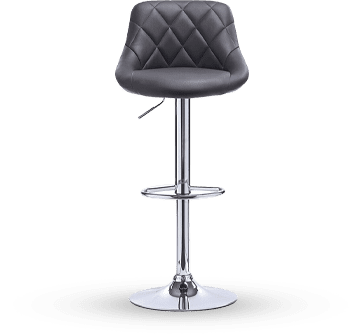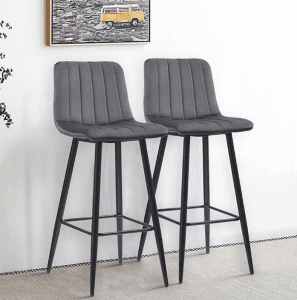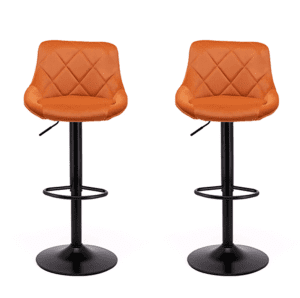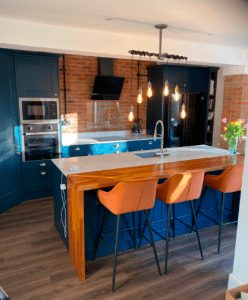5 Barstool Parts— Do You Know What They Are
Most barstools come unassembled and getting acquainted with the various barstool parts beforehand can help you assemble them. Today, we’re going to tell you about the different stool parts that you will receive and then ways to keep your barstool in pristine condition.
5 Different Barstool Parts
Following is a list of five different barstool parts:
1. Barstool Base
A barstool base ensures stability. There are two types of common barstool bases:
- Round Conical Barstool Base stabilises the round bases. Underneath the base, there is a rubber ring that protects floors from scuffs and scratches. In the centre, there is a hole that supports the gas lift mechanism.
- Flat Barstool Base can be either square or round-shaped. They are heavier and reduce the centre of gravity to neutralise the barstool seat. Beneath the base, there is a felt or rubber pad that protects the floor surfaces.
2. Barstool Gas Lift
Hydraulic gas lifts give stools the ability to adjust to various heights and swivel 360 degrees. A hydraulic consists of two cylinders with a valve placed between them. The valve’s function is to control the airflow. You can raise and lower the stool using the lever protruding from underneath the seat.
Hydraulic gas lifts go into the hole on the round barstool base. Using a compression joint, the gas lift locks into place. Most gas lifts come with a decorative collar that goes between the hydraulic cylinder and the barstool base. Several bolts hold the hydraulic cylinder in place on flat barstool bases. You can use an Allen key that comes with the barstool to tighten the bolts.
3. Barstool Footrest
Barstool footrests are soldered into the slender chrome leg that protects the valve found between the two cylinders of the gas lift. Footrests are available in various shapes such as a half-moon, triangular, square, or circle design. On the top section, there’s a lever used to activate the hydraulic.
4. Barstool Head
Barstool head is the seat, which is attached to the footrest using four bolts and washers. The seats come in a wide range of fabrics such as velvet and faux leather. They are padded with some offering armrests for added comfort.
5. Barstool Bolts (4 in Total)
Barstools come with bolts and spacers, which are placed between the screw holes in the front and the metal plate above the footrest. This increases the gap and creates a slight incline. It not only improves the design but also gives the impression of a comfortable seating position.
However, knowing about the different barstool parts isn’t enough, as you need to learn how each part comes together to create a barstool. You can refer to this illustration and this blog on “How to build a barstool” to assemble your stools. Once assembled and paired with your kitchen island or counter, next on the agenda is barstool maintenance.
Barstool Maintenance
We use high-quality materials to create our striking barstools. This means the fabric will not wear out and the chrome polish will not succumb to rust and corrosion over time. We do our part in ensuring you get only the best but are you doing your part to ensure you keep your barstool looking the best?
Just like you clean the floor, do laundry, and dust the furniture, the same way you need to care for your barstools. You need to know what to do if a spill occurs and when stains and marks appear. The answer is simple— you prevent your stools from looking older than they are by performing routine barstool maintenance.
If you want all the barstool parts to function flawlessly and look impeccable as they did on day one, get cleaning!
How to Clean Chrome Polished Barstools
Keep your barstool looking new by taking the following steps to clean your chrome polished stool:
1. Wipe It Down
Use a clean cloth and warm and soapy water to wipe every chromed surface on the barstool. We recommend cleaning the chrome parts at least once a week to remove stains from spills and prevent dust from accumulating. For dark marks, use alcohol. If a spill occurs, you need to clean it immediately. Products: Alcohol absorbs water from chrome and removes all watermarks from it.
2. Remove Rust
Although chrome polish is corrosion-resistant, rust and dark marks can still taint the beauty of the stool if you neglect to do barstool maintenance for several years. You can make sure the chrome remains rust-free by cleaning it with aluminium foil. Aluminium foil can remove rust from the chrome. You need to clean the chrome with aluminium foil’s shiny side.
When you crumple the foil into a ball, ensure the shiny side is outside. Next, dip the foil into the water and rub it against the dark stains and rust to remove them. Products: Aluminium foil breaks up the rust by taking oxygen from the rust as it starts to oxidise.
3. Polish It
You have cleaned your stools with water and aluminium foil. Now, it’s time to return your barstools’ shine to them. Take a clean cloth such as microfibre or cotton cloth and dip into WD-40 or furniture polish and then rub it all over the surface. Products: WD-40 and baby oil remove streaks, preserve the stool’s shine, prevent corrosion, and remove fingerprints. Furniture polish adds another protective layer by preventing stains and marks.
You’re almost done cleaning your stools. The last thing you need to look after is the faux leather or velvet fabric.
Faux Leather
Compared to real leather, faux leather requires minimal maintenance and is waterproof and scratch-resistant. If you have small children, faux leather stools will not ruin your day or keep you on the edge in the event of spills because they are non-absorbent. You can use a duster to remove dust and a damp cloth to remove marks. For tough stains, dip the cloth in soapy water. Check out our faux bar stools for sale.
Velvet Material
Velvet material feels good to the touch. It’s fun to brush the fabric with your hands. Brushing it in various directions gives the velvet an unappealing appearance though. With velvet, brushing it down creates a lighter and smoother look, and brushing it up creates a darker and coarser look.
The two different directions will not look like abstract art to the eye but imperfections. To avoid that, brush the velvet in the same direction. You can either do it by hand or buy a double-sided brush. The latter is preferred.
Brush the velvet regularly to lift the material, prevent it from becoming flattened, and remove dust and dirt trapped between the fibres. In case of a spill, use a dry cloth to lightly blot, not scrub the liquid from the material. Once dry, brush it to prevent the fibres from becoming matted. Check out our velvet adjustable stool.
When you get your barstool delivered to you, there will be no confusion because you’ll know what to do!
Explore our selection of premium quality bar stools for sale today. If you have any questions on how to assemble and maintain your stools, you can get in touch with us. We serve Dublin, Galway, Cork, and wherever in Ireland a bar stool is needed.
re?
Most bar stools come unassembled and getting acquainted with the various bar stool parts beforehand can help you assemble them. Today, we’re going to tell you about the different stool parts that you will receive and then ways to keep your bar stool in pristine condition.
5 Different Barstool Parts
Following is a list of five different bar stool parts:
1. Bar stool Base
A bar stool base ensures stability. There are two types of common bar stool bases:
- Round Conical Barstool Base stabilises the round bases. Underneath the base, there is a rubber ring that protects floors from scuffs and scratches. In the centre, there is a hole that supports the gas lift mechanism.
- Flat Barstool Base can be either square or round-shaped. They are heavier and reduce the centre of gravity to neutralise the barstool seat. Beneath the base, there is a felt or rubber pad that protects the floor surfaces.
2. Bar stool Gas Lift
Hydraulic gas lifts give stools the ability to adjust to various heights and swivel 360 degrees. A hydraulic consists of two cylinders with a valve placed between them. The valve’s function is to control the airflow. You can raise and lower the stool using the lever protruding from underneath the seat.
Hydraulic gas lifts go into the hole on the round barstool base. Using a compression joint, the gas lift locks into place. Most gas lifts come with a decorative collar that goes between the hydraulic cylinder and the barstool base. Several bolts hold the hydraulic cylinder in place on flat barstool bases. You can use an Allen key that comes with the barstool to tighten the bolts.
3. Bar stool Footrest
Barstool footrests are soldered into the slender chrome leg that protects the valve found between the two cylinders of the gas lift. Footrests are available in various shapes such as a half-moon, triangular, square, or circle design. On the top section, there’s a lever used to activate the hydraulic.
4. Bar stool Head
Barstool head is the seat, which is attached to the footrest using four bolts and washers. The seats come in a wide range of fabrics such as velvet and faux leather. They are padded with some offering armrests for added comfort.
5. Bar stool Bolts (4 in Total)
Barstools come with bolts and spacers, which are placed between the screw holes in the front and the metal plate above the footrest. This increases the gap and creates a slight incline. It not only improves the design but also gives the impression of a comfortable seating position.
However, knowing about the different barstool parts isn’t enough, as you need to learn how each part comes together to create a barstool. You can refer to this illustration and this blog on “How to build a barstool” to assemble your stools. Once assembled and paired with your kitchen island or counter, next on the agenda is barstool maintenance.
Barstool Maintenance
We use high-quality materials to create our striking barstools. This means the fabric will not wear out and the chrome polish will not succumb to rust and corrosion over time. We do our part in ensuring you get only the best but are you doing your part to ensure you keep your barstool looking the best?
Just like you clean the floor, do laundry, and dust the furniture, the same way you need to care for your barstools. You need to know what to do if a spill occurs and when stains and marks appear. The answer is simple— you prevent your stools from looking older than they are by performing routine barstool maintenance.
If you want all the barstool parts to function flawlessly and look impeccable as they did on day one, get cleaning!
How to Clean Chrome Polished Barstools
Keep your barstool looking new by taking the following steps to clean your chrome polished stool:
1. Wipe It Down
Use a clean cloth and warm and soapy water to wipe every chromed surface on the barstool. We recommend cleaning the chrome parts at least once a week to remove stains from spills and prevent dust from accumulating. For dark marks, use alcohol. If a spill occurs, you need to clean it immediately. Products: Alcohol absorbs water from chrome and removes all watermarks from it.
2. Remove Rust
Although chrome polish is corrosion-resistant, rust and dark marks can still taint the beauty of the stool if you neglect to do barstool maintenance for several years. You can make sure the chrome remains rust-free by cleaning it with aluminium foil. Aluminium foil can remove rust from the chrome. You need to clean the chrome with aluminium foil’s shiny side.
When you crumple the foil into a ball, ensure the shiny side is outside. Next, dip the foil into the water and rub it against the dark stains and rust to remove them. Products: Aluminium foil breaks up the rust by taking oxygen from the rust as it starts to oxidise.
3. Polish It
You have cleaned your stools with water and aluminium foil. Now, it’s time to return your barstools’ shine to them. Take a clean cloth such as microfibre or cotton cloth and dip into WD-40 or furniture polish and then rub it all over the surface. Products: WD-40 and baby oil remove streaks, preserve the stool’s shine, prevent corrosion, and remove fingerprints. Furniture polish adds another protective layer by preventing stains and marks.
You’re almost done cleaning your stools. The last thing you need to look after is the faux leather or velvet fabric.
Faux Leather bar stools
Compared to real leather, faux leather requires minimal maintenance and is waterproof and scratch-resistant. If you have small children, faux leather stools will not ruin your day or keep you on the edge in the event of spills because they are non-absorbent. You can use a duster to remove dust and a damp cloth to remove marks. For tough stains, dip the cloth in soapy water. Check out our faux bar stools for sale.
Velvet Material
Velvet material feels good to the touch. It’s fun to brush the fabric with your hands. Brushing it in various directions gives the velvet an unappealing appearance though. With velvet, brushing it down creates a lighter and smoother look, and brushing it up creates a darker and coarser look.
The two different directions will not look like abstract art to the eye but imperfections. To avoid that, brush the velvet in the same direction. You can either do it by hand or buy a double-sided brush. The latter is preferred.
Brush the velvet regularly to lift the material, prevent it from becoming flattened, and remove dust and dirt trapped between the fibres. In case of a spill, use a dry cloth to lightly blot, not scrub the liquid from the material. Once dry, brush it to prevent the fibres from becoming matted. Check out our velvet adjustable stool.
When you get your barstool delivered to you, there will be no confusion because you’ll know what to do!
Explore our selection of premium quality bar stools for sale today. If you have any questions on how to assemble and maintain your stools, you can get in touch with us. We serve Dublin, Galway, Cork, and wherever in Ireland a barstool is needed.
Bar stools Ireland








